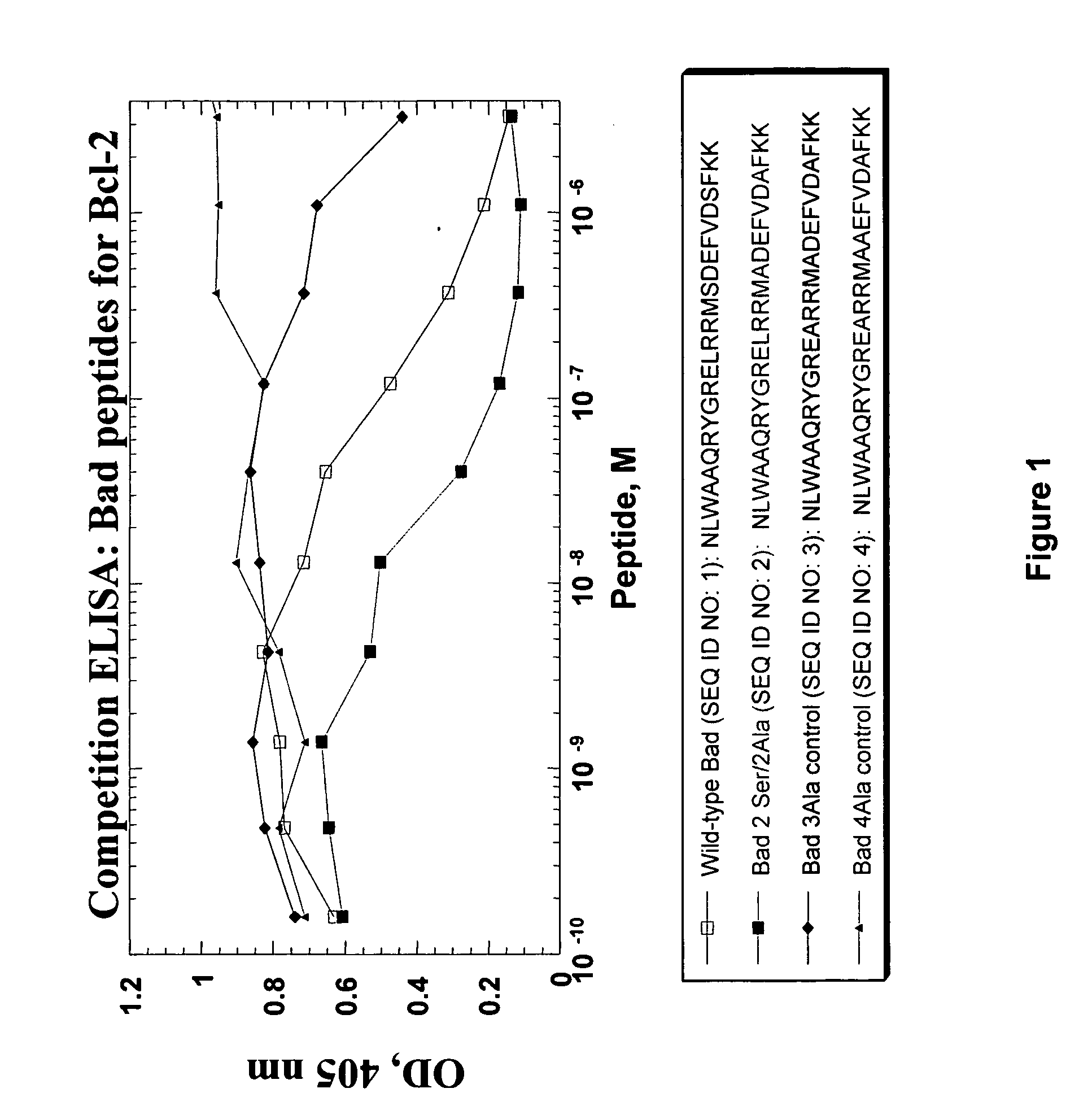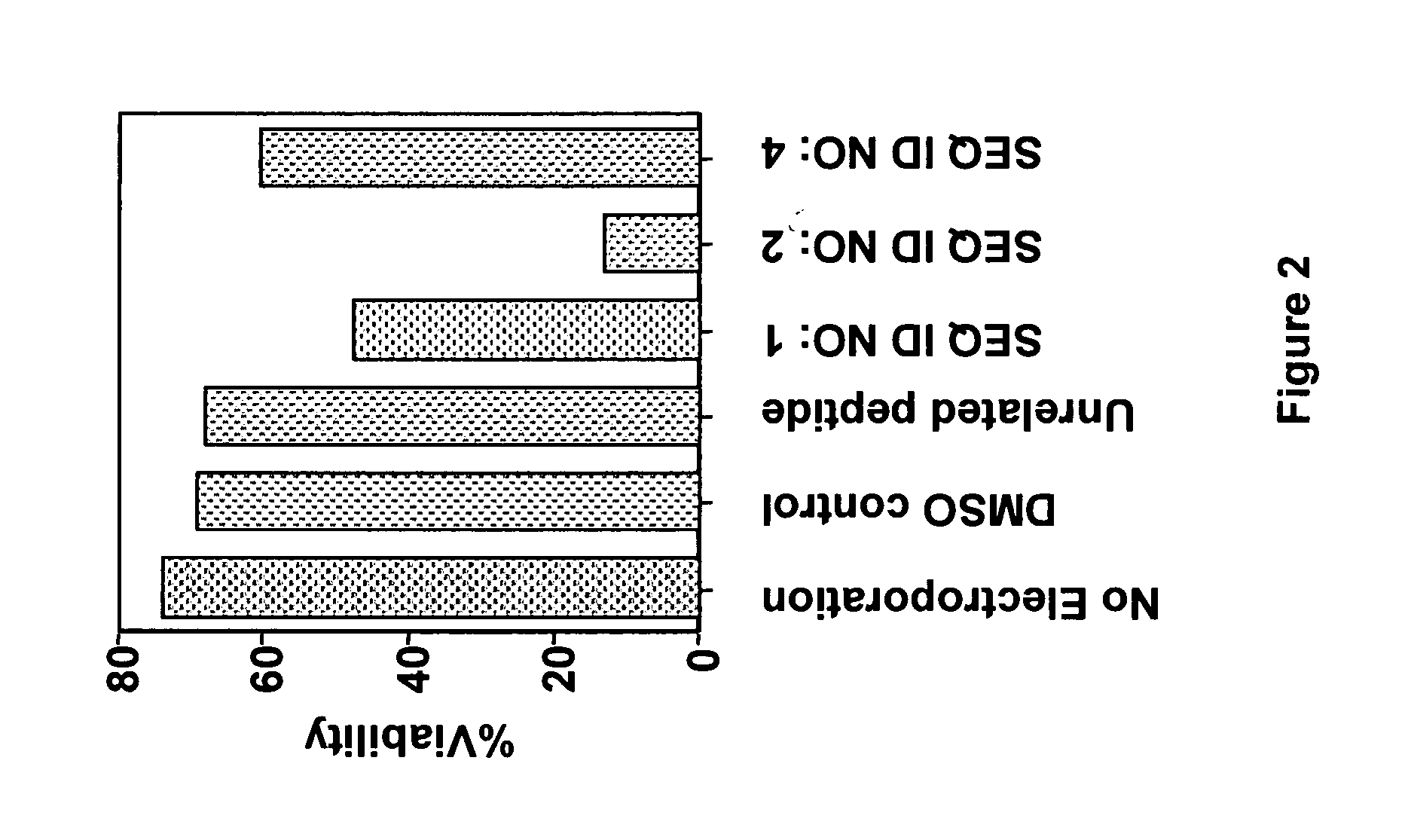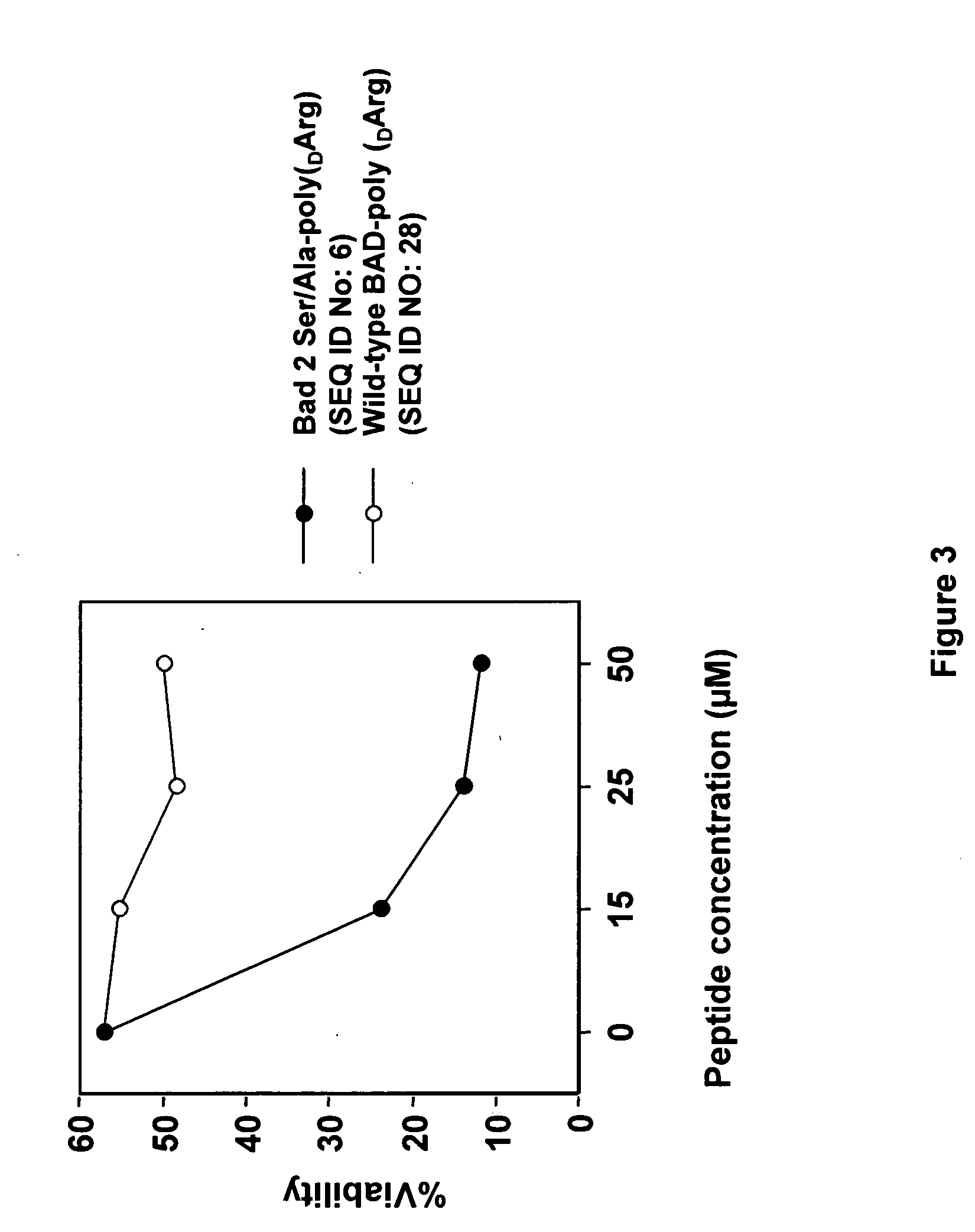Peptide drugs for chronic lymphocytic leukemia (CLL) and other cancers
a technology of peptide drugs and leukemia, applied in the field of cancer and molecular medicine, can solve the problems of only partially successful current cancer therapies and reduced bcl-2 expression or activity
- Summary
- Abstract
- Description
- Claims
- Application Information
AI Technical Summary
Benefits of technology
Problems solved by technology
Method used
Image
Examples
example i
Induction of Apoptosis in Cancer Cells With Modified BAD Peptides
A. Binding Affinity of Modified BAD Peptides to Bcl-2
[0061] Several wild type, modified and control BAD peptides were prepared by standard solid phase synthesis: wild type BAD peptide NLWAAQRYGRELRRM SDEFVDSFKK (SEQ ID NO: 1); modified BAD peptide 2Ser / Ala NLWAAQRYGRELRRMADEFVDAFKK (SEQ ID NO: 2); BAD 3A control NLWAAQRYGREARRMADEFVDAFKK (SEQ ID NO:3) and BAD 4A control NLWAAQRYGREARRMAAEFVDAFKK (SEQ ID NO: 4). See Table 1 above.
[0062] To determine binding affinity to Bcl-2, competition ELISA assays were performed essentially as described in Cabezas et al., supra, 2001, with the following components. Briefly, acetyl-Cys(biotin-BMCC)-Ahx-Bad peptide (50 ng peptide / 50 μl ELISA buffer) was adsorbed to 96-well neutraAvidin coated microtiter plates. Competition peptides were subsequently mixed with 50 ng GST-Bcl2(1-205; Santa Cruz Biotechnology; Santa Cruz, Calif.) in 50 μl ELISA buffer per titer well and incubated for ...
example ii
Induction of Apoptosis Using Modified BAD Peptides with Poly-Arginine Cell Penetration Sequences
A. Apoptosis in CLL Cells by Modified BAD Peptides Including a Poly-Arginine Cell Penetration Sequence
[0068] The wild type and modified BAD peptides fused to poly-arginine cell penetration sequences shown in Table 5 were synthesized by standard solid phase synthesis. CLL cell viability assays were performed as described above except that cell permeable peptides SEQ ID NOS: 28, 6 and 29 and the control, non-permeable peptide SEQ ID NO: 3 (see Table 5) were added directed to CLL cells in culture without electroporation.
TABLE 5Wild type and modified BAD peptides withpoly-arginine delivery agent sequencesPeptide / SEQ ID NO:Amino acid sequenceWild type Bad poly(DArg)NLWAAQRYGRELRRMSDEFVDSFKKC-Ahx*-(DArg)8SEQ ID NO: 28Bad 2Ser / Ala poly(DArg)NLWAAQRYGRELRRMADEFVDAFKKC-Ahx-(DArg)8SEQ ID NO: 6Bad 3A controlNLWAAQRYGREARRMADEFVDAFKKSEQ ID NO: 3Bad 4A control poly(DArg)NLWAAQRYGREARRMAAEFVDAFKKC...
example iii
Induction of Apoptosis Using Modified BAD Peptides Fused to Penetratin
[0074] The Bad 2Ser / Ala peptide (SEQ ID NO:2) was synthesized as a disulfide linked fusion peptide with penetratin-1 (SEQ ID NO: 27). The peptide, designated 2335, a BAD-BH3 peptide, has the sequence: acetyl-NLWAAQRYGRELRRMADEFVDAFKKC-CRQIKIWFQNRRMKWKK-amide (SEQ ID NO: 31). The C—C indicates the linkage of the Bad 2S / A peptide to the cell-penetrating peptide, penetratin, by a disulfide linkage. An enantiomer control peptide was designated 2336: acetyl-NLWAAQRYGRELRRMADEFVDAFKKC-CRQIKIWFQNRRMKWKK-amide (SEQ ID NO: 32). The 2336 peptide is an all D-amino acid peptide that does not bind Bcl-2 family Bcl-2 / x1 and is an inactive control peptide. Both peptides are acetylated at the N-terminus and amidated at the C-terminus.
[0075] The peptides were tested in cell viability assays essentially as described above in Examples I and II. Experiments were carried out in 697-neo and 697-Bcl-2 cells. 697 cells are from a cell ...
PUM
| Property | Measurement | Unit |
|---|---|---|
| affinity | aaaaa | aaaaa |
| concentrations | aaaaa | aaaaa |
| allosteric conformational change | aaaaa | aaaaa |
Abstract
Description
Claims
Application Information
 Login to View More
Login to View More - R&D
- Intellectual Property
- Life Sciences
- Materials
- Tech Scout
- Unparalleled Data Quality
- Higher Quality Content
- 60% Fewer Hallucinations
Browse by: Latest US Patents, China's latest patents, Technical Efficacy Thesaurus, Application Domain, Technology Topic, Popular Technical Reports.
© 2025 PatSnap. All rights reserved.Legal|Privacy policy|Modern Slavery Act Transparency Statement|Sitemap|About US| Contact US: help@patsnap.com



